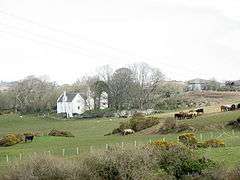Cwm Cadnant
| Cwm Cadnant | |
 Hafoty |
|
 Cwm Cadnant |
|
| Population | 2,254 (2011) |
|---|---|
| OS grid reference | SH5674 |
| Community | Cwm Cadnant |
| Principal area | Anglesey |
| Ceremonial county | Gwynedd |
| Country | Wales |
| Sovereign state | United Kingdom |
| Post town | BEAUMARIS |
| Postcode district | LL59 |
| Dialling code | 01248 |
| Police | North Wales |
| Fire | North Wales |
| Ambulance | Welsh |
| EU Parliament | Wales |
| UK Parliament | Ynys Môn |
| Welsh Assembly | Ynys Môn |
Coordinates: 53°14′53″N 4°09′11″W / 53.248°N 4.153°W
Cwm Cadnant is a community and electoral ward in Anglesey, north Wales. Named after the local river, Afon Cadnant, which flows through it, the community takes in the area between the Menai Bridge and Beaumaris. It includes the villages of Llandegfan and Llansadwrn and at the 2001 census it had a population of 2,222,[1] increasing slightly to 2,254 at the 2011 census.[2]
The lower part of the Afon Cadnant, which passes through part of Llandegfan is Cadnant Dingle, a Site of Special Scientific Interest.[3] The site was selected as an example of Brachypodium sylvaticum ‑ Quercus/Fraxinus broadleaved woodland.[4]
Buildings of note
The area has a long history with several buildings of note. St Sadwrn's church in the village of Llansadwrn contains a 6th-century memorial to Saint Saturnius after whom the church and subsequently the village is named.[5][6] The area was once the site of Treffos Manor, the medieval residence of the Bishop of Bangor, but there are no visible remains and the site is now contains an isolated farm house.[7] Cwm Cadnant is also home to Hafoty, described as one of the finest medieval houses on Anglesey.[1] Home to the constable of Beaumaris Castle around the 1530s, Hafoty is believed to have been originally constructed in the second quarter of the 14th century.[8]
Cwm Cadnant also contains several earthworks and standing stones.
References
- 1 2 Davies, John; Jenkins, Nigel; Menna, Baines; Lynch, Peredur I., eds. (2008). The Welsh Academy Encyclopaedia of Wales. Cardiff: University of Wales Press. p. 180. ISBN 978-0-7083-1953-6.
- ↑ "Ward/Community population 2011". Retrieved 19 May 2015.
- ↑ "Cadnant Dingle". CCW.gov.uk. Retrieved 20 March 2013.
- ↑ "Cadnant Dingle SSSI". angleseynature.co.uk. Retrieved 22 April 2012.
- ↑ Lewis, Samuel. "Llansadwrn". A Topographical Dictionary of Wales. genuki.org.uk. Retrieved 22 April 2012.
- ↑ Ford, David Nash. "St. Sadwrn Farchog of Llansadwrn". earlybritishkingdoms.com. Retrieved 22 April 2012.
- ↑ "Treffos manor of Bishop of Bangor". gatehouse-gazetteer.info. Retrieved 22 April 2012.
- ↑ Emery, Anthony (2008). Greater Medieval Houses of England and Wales, 1300-1500: East Anglia, Central England, and Wales. Cambridge: Cambridge University Press. p. 666. ISBN 978-0521581318.
External links
- A Vision of Britain Through Time: Llandegfan
- A Vision of Britain Through Time: Llansadwrn
- British Listed Buildings
- Genuki: Llandegfan
- Genuki: Llansadwrn
- Geograph
- Office for National Statistics
